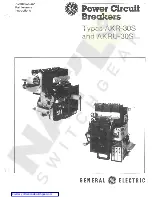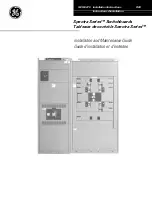
For more information visit: www.EatonElectrical.com
Instructions for VR-Series
Replacement Breakers for
Westinghouse Type B20B/B22B
I.B. 94A1994R01
Page 27
Effective: April 2005
IB01301018E
6.4 VACUUM INTERRUPTER INTEGRITY TEST
Vacuum interrupters used in Type VR-Series circuit breakers are
highly reliable interrupting elements. Satisfactory performance of
these devices is dependent upon the integrity of the vacuum in the
interrupter and the internal dielectric strength. Both of these
parameters can be readily checked by a one minute AC high
potential test. (See Table 6.1 for appropriate test voltage.) During
this test, the following warning must be observed:
APPLYING ABNORMALLY HIGH VOLTAGE ACROSS A PAIR OF
CONTACTS IN VACUUM MAY PRODUCE X-RADIATION. THE
RADIATION MAY INCREASE WITH THE INCREASE IN VOLTAGE
AND/OR DECREASE IN CONTACT SPACING. X-RADIATION
PRODUCED DURING THIS TEST WITH RECOMMENDED VOLTAGE
AND NORMAL CONTACT SPACING IS EXTREMELY LOW AND
WELL BELOW MAXIMUM PERMITTED BY STANDARDS.
HOWEVER, AS A PRECAUTIONARY MEASURE AGAINST
POSSIBILITY OF APPLICATION OF HIGHER THAN RECOM-
MENDED VOLTAGE AND/OR BELOW NORMAL CONTACT
SPACING, IT IS RECOMMENDED THAT ALL OPERATING PER-
SONNEL STAND AT LEAST ONE METER AWAY IN FRONT OF THE
BREAKER.
With the breaker open and securely sitting on the floor, connect all
top/front primary studs (bars) together and the high potential
machine lead. Connect all bottom/rear studs together. Do not
ground them to the breaker frame. Start the machine at zero
potential, increase to appropriate test voltage and maintain for one
minute.
Successful withstand indicates that all interrupters have
satisfactory vacuum level. If there is a breakdown, the defective
interrupter or interrupters should be identified by an individual
test and replaced before placing the breaker in service.
After the high potential is removed, discharge any electrical charge
that may be retained, particularly from the center shield of vacuum
interrupters. To avoid any ambiguity in the AC high potential test
due to leakage or displacement (capacitive) current, the test unit
should have sufficient volt-ampere capacity. It is recommended that
the equipment be capable of delivering 25 milliamperes for one
minute.
Although an AC high potential test is recommended, a DC test may
be performed if only a DC test unit is available.
In this case the equipment must be capable of delivering 5
milliamperes for one minute to avoid ambiguity due to field emission
or leakage currents and the test voltage shall be as shown in Table
6.1.
The current delivery capability of 25 mA AC and 5 mA DC apply
when all three VI's are tested in parallel. If individual VI's are tested,
current capability may be one third of these values.
SOME DC HIGH POTENTIAL UNITS, OPERATING AS UNFILTERED
HALF-WAVE RECTIFIERS, ARE NOT SUITABLE FOR USE TO TEST
VACUUM INTERRUPTERS BECAUSE THE PEAK VOLTAGE
APPEARING ACROSS THE INTERRUPTERS CAN BE SUBSTAN-
TIALLY GREATER THAN THE VALUE READ ON THE METER.
6.5 CONTACT EROSION AND WIPE
Since the contacts are contained inside the interrupter, they remain
clean and require no maintenance. However, during high current
interruptions there may be a minimal amount of erosion from the
contact surfaces. Maximum permitted erosion is 1/8 inch. To
determine contact erosion, close the breaker and observe the
vacuum interrupter moving stem from the rear of the breaker. If the
mark on each stem is visible, erosion has not reached maximum
value thus indicating satisfactory contact surface of the interrupter.
If the mark is not visible, the vacuum interrupter assembly must be
replaced (Figure 6-2 and 6-3).
The adequacy of contact wipe can be determined by simply
observing the vacuum interrupter side of the operating rod assembly
on a closed breaker. Figures 6-4 and 6-5 show the procedure for
determining the contact wipe. It maybe necessary to use a small
mirror and flashlight to clearly see the “T” shape indicator. If the
wipe is not adequate, the vacuum interrupter assembly (Pole Unit)
must be replaced. Field adjustment is not possible.
d
e
t
a
R
r
e
k
a
e
r
B
e
g
a
t
l
o
V
m
u
m
i
x
a
M
e
g
a
t
l
o
V
t
s
e
T
y
t
i
r
g
e
t
n
I
r
e
t
p
u
r
r
e
t
n
I
m
u
u
c
a
V
z
H
0
6
C
A
C
D
g
n
i
d
u
l
c
n
i
d
n
a
o
t
p
U
V
k
0
.
5
1
V
k
7
2
V
k
0
4
Table 6.1 - Voltages
WARNING
WARNING














































